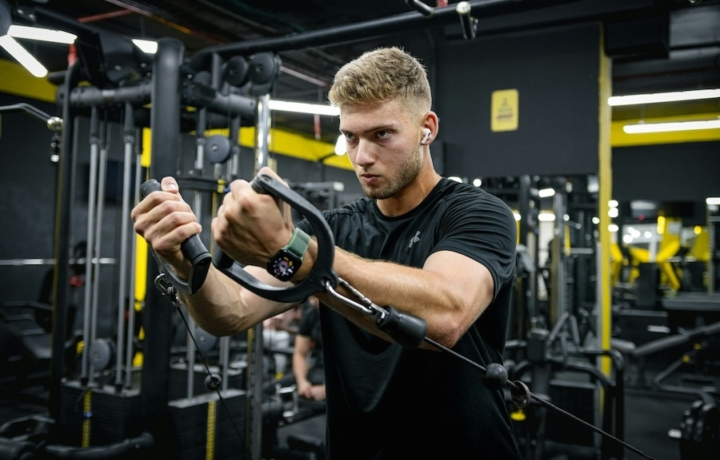Exercise
Middle Cable Chest Fly

Middle Cable Chest Fly
How to Perform
- Adjust the cable pulleys on both sides of the machine to chest height and select appropriate weight for your level.
- Stand in the center of the cable station with your feet shoulder-width apart, core engaged, and a slight bend in your knees for stability.
- Grasp a handle in each hand, step forward into a split stance position, and bring your hands together in front of your chest with elbows slightly bent.
- Maintain a neutral spine position with your shoulders pulled back and down, chest lifted, and a slight forward lean from your hips.
- Inhale and slowly open your arms out to the sides, keeping a consistent bend in your elbows while maintaining tension in your chest muscles.
- Allow the cables to pull your arms back only until you feel a comfortable stretch across your chest, usually when your hands are aligned with your shoulders.
- Exhale forcefully as you contract your chest muscles to bring your hands back together in a controlled arc motion in front of your chest.
- Maintain tension throughout the movement by not allowing the handles to touch at the center position, keeping constant resistance on the chest muscles.
Important information
- Keep your wrists neutral and aligned with your forearms throughout the entire movement to prevent strain.
- Make sure your elbows maintain a consistent bend (about 15-20 degrees) rather than locking out or bending too much.
- Control the movement in both directions, avoiding the temptation to let the weight pull your arms back too quickly.
- If you feel the exercise primarily in your shoulders rather than your chest, try adjusting the cable height or decreasing the range of motion.

Middle Cable Chest Fly
Exercise Details
Primary Muscles
Muscle Groups
Mechanic
Risk Areas
Built for progress
Take the guesswork out of training
Create personalized AI-powered workout plans that evolve with you. Train smarter, track every rep and keep moving forward, one workout at a time.






The Middle Cable Chest Fly stands as a stellar intermediate-level exercise that specifically targets the pectoral muscles while engaging the front deltoids as secondary movers. This movement has earned its place in countless bodybuilding and strength-focused routines due to its effectiveness at isolating the chest through a controlled horizontal adduction pattern. Unlike free weight alternatives, the cable machine provides consistent tension throughout the entire range of motion, making the middle chest fly particularly valuable for developing that coveted pec separation and definition. The constant resistance challenges the muscle fibers differently than traditional pressing movements, stimulating growth through increased time under tension: a key factor for hypertrophy-focused bodybuilding programs.
For strength enthusiasts, the middle cable fly serves as an excellent accessory movement that addresses potential imbalances between the left and right sides of the chest. This bilateral balance is crucial for maximizing performance in compound pressing movements like the bench press. The isolation nature of this exercise allows you to strengthen the pectoral muscles without the limitation of other muscle groups failing first. What makes this exercise especially valuable for intermediate lifters is its scalability.
As your strength progresses, you can easily adjust the resistance to continue challenging the muscles appropriately. This progression capability makes it a staple in periodized training programs designed to build both aesthetic chest development and functional pushing strength. The middle cable fly's effectiveness comes from its ability to create maximal tension at the point where the pectoral muscles are fully contracted. This peak contraction, difficult to achieve with free weights due to the changing resistance curve, is precisely why bodybuilders rely on this movement to sculpt a well-defined chest shelf that stands out on stage or at the beach.
FAQ - Middle Cable Chest Fly
The Middle Cable Chest Fly primarily targets the pectoral muscles (especially the mid-chest fibers), with secondary engagement of the anterior deltoids and biceps. The constant cable tension particularly emphasizes the pec fibers responsible for horizontal adduction, promoting chest separation and definition.
Stand in the center of a cable station with cables set at chest height, feet shoulder-width apart, and a slight forward lean from the hips. Keep your elbows slightly bent (not locked) throughout the movement, and focus on squeezing your chest as you bring the handles together directly in front of your sternum.
Beginners can use lighter weight and perform the movement with a stability ball against the back for support. For advanced variations, increase the weight, add a slight pause at the point of maximum contraction, or perform the exercise on one knee or in a split stance to engage more core stabilizers.
The most common mistake is rushing through the movement without focusing on the quality of the rolling motion. Other errors include using excessive tension rather than controlled movement, and failing to achieve full range of motion through all three planes of shoulder movement (flexion, depression, and retraction).
Include this exercise 1-2 times weekly as part of your chest training. Position it after your compound pressing movements (bench press, push-ups) when training for hypertrophy, or use it as a pre-exhaust technique before pressing movements when focusing on developing mind-muscle connection.







